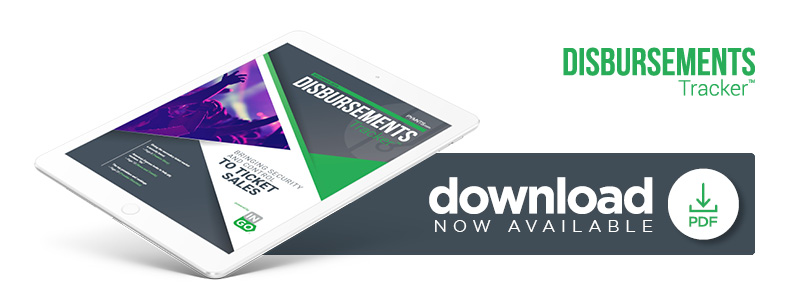Bringing Security And Control To Ticket Sales

Secondary ticket sales for live events bring in more than $35 billion annually. Most of those funds, though, need to be disbursed back to the consumers who sold them — a process rife with roadblocks and challenges, which often leaves all parties in the dark about who they’re dealing with. According to Stephen Glicken, CEO and co-founder of Project Admission, this results in safety risks and payment delays. In the latest Disbursements Tracker, Glicken explains how the company is working to give ticket disbursements a speed and security boost.
Putting on large-scale, live entertainment events — from concerts to ball games to TED Talks or any other major gathering of people — and selling tickets to those events has always been big business, but so is reselling those tickets on secondary markets.
What was once the domain of seedy characters hanging out around arenas and stadiums hoping to resell tickets has become a thriving — and legitimate — industry. Marketplace platforms like StubHub have pushed the ticket resale market to become a more than $35 billion industry as of 2017, and the space is expected to grow at a CAGR of more than 6 percent per year through 2022.
The secondary ticket market may be a rapidly growing space, but it’s also one rife with roadblocks and challenges, according to Stephen Glicken, CEO and co-founder of Project Admission, a ticket resale platform. In a recent interview with PYMNTS, he noted that, while these platforms provide a valuable service to concertgoers, ticket sellers, venues and artists, many of these parties are left in the dark when it comes to information about exactly who they’re dealing with, which can lead to risks and delays.
“There are a lot of issues within the ticketing landscape,” Glicken said, noting that as much as 40 percent of tickets sold to any event wind up being resold on a secondary marketplace. “What we’re really trying to do is connect some of the dots in this industry and join together what’s a pretty entrenched and fragmented infrastructure.”
Tracking Tickets — and Buyers
One of the biggest issues with the current methods of selling secondhand tickets is the lack of information about who’s making a purchase and what happens to the ticket after it’s transferred. Glicken pointed out that secondhand ticket platforms often know plenty of information about sellers, who are required to create an account before posting tickets, provide proof of their identities and provide relevant payment information, such as bank account numbers. Buyers, on the other hand, can often make purchases as guests without registering an account, and can even pay with gift cards or other forms of payment that may mask their identities.
“[A lack of] data is one of the biggest problems in the industry,” he said. “We don’t know who’s in the room, who’s buying these tickets … you sell a bunch of tickets, which then get dispersed into third-party marketplaces that are not connected with the rights holder or the primary ticketing company.”
This can introduce a layer of risk for sellers, as well as for the platforms that facilitate the transactions. Sellers who complete a transaction with a buyer who fails to promptly pay may be left hanging — or, because many platforms, including StubHub, guarantee payments to sellers, they could be the ones waiting for a debt to be repaid.
This lack of information on buyers can also affect venues, which are increasingly eager to understand who is attending live events, due in large part to violent incidents in the past. Currently, venues lack the information on attendees that could be used to assess any potential threats.
Glicken and his team have worked to solve this problem by applying QR codes to tickets that include details about buyers and sellers, in much the same way that airplane and transit passes carry information on the holder. This transaction information is not just limited to the most recent purchase, but can also be used to trace a ticket’s path from the original seller to the final purchaser.
“What we’re building is a label software that could integrate with any company in order to help take over and manage the distribution and sale of digital tickets,” he said. “What we’ve really done, I think, is built a simple platform that converts the ticket into kind of an airplane ticket.”
Simplifying Transfers
The amount of information included in secondary ticket transactions could also provide faster, simpler and more secure disbursements to sellers and ticket transfers to buyers, Glicken noted. Project Admission provides an API that improves the ticket transfer process, allowing sellers to send tickets directly to buyers once a transaction has been completed, rather than using intermediary methods like emails, PDF links or even sending them by mail.
“You’re basically swapping ownership directly online with our platform,” he explained. “It’s all part of the platform of the ticket.”
Because sellers’ payments are often dependent on the tickets arriving to recipients safely and as expected, speeding up this transfer process doesn’t just get tickets into the hands of buyers more quickly — making it feasible for them to make last-minute ticket purchases — but also gets funds to sellers faster.
There’s another additional benefit, Glicken claimed — one that could help quiet one of the loudest criticisms of the secondary market: outrageously high prices. With the API, artists can place price or resale caps on tickets, ensuring that fans aren’t held hostage by scalpers looking for a quick payday.
Keeping ticket prices low enough for the average consumer to afford, while still enabling resellers to make profits, will likely become increasingly important for ticket resale markets going forward. After all, while the market continues to expand its customer base, locking customers out of the arena due to high prices could stop all of that growth in its tracks.
About the Tracker
The Disbursements Tracker™, powered by Ingo Money, is the go-to resource for staying up to date on a month-by-month basis on trends and changes in the digital disbursement space.

